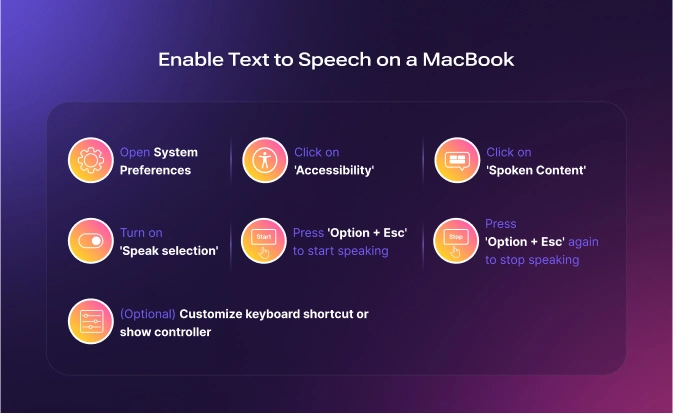How to Convert Text to Speech on a MacBook

Make Your MacBook Read for You
Whether you prefer to have content read to you when busy, are too tired to read, or are a special needs individual, the text to speech feature on MacBook can prove to be a boon. With just a few clicks or key combinations, users can transform any text into speech, saving time and boosting productivity. You can now turn your favorite books or articles into speech and listen to them read aloud anywhere, anytime—without having to carry the books or flip through each page physically.
Furthermore, not everyone has time to read lengthy documents or time-consuming emails on their Mac. This is where the text to speech in Mac serves as an easier way to consume content without straining one's eyes. In this blog, we'll dive into the top benefits of using this powerful function to transform how users interact with their device, how to use the feature with just a press of a key combo, and some of the alternatives to MacBook text to speech.
How to Enable Text to Speech on a MacBook?

To enable MacBook to speak selected text, simply press the key combination 'Option + Esc.' There is also an alternative option to customize the keyboard shortcut to use other features. For example, users can decide to display a controller on the screen that enables them to quickly alter the speech rate, resume, or stop speaking using the play button. Here are the steps to enable TTS on Mac:
Step 1: On MacBook, select Apple Menu > System Settings. Then, click on the 'Accessibility' option in the sidebar. (You may need to scroll down.)
Step 2: Click on 'Spoken Content.'
Step 3: Next, turn on 'Speak selection.'
Step 4: Press the default key combination 'Option + Esc.' The TTS will now start speaking in its system voice. If a particular text is marked when pressing the key combination, Mac will speak the selected text in the default voice. Else, present text items in the current window are spoken. For instance, if a new window consists of Mail, an email message is read aloud. If no text items are available on the screen, one can hear a beep.
Step 5: Press the key combination 'Option + Esc' again to stop the text to speech feature. The default voice will now stop speaking.
Note: If users set the option to automatically show the controller, it appears on the screen when the Mac starts speaking. The controller can be used to move forwards or backward one sentence in the text.
Why Text to Speech Software Over the Text to Speech Feature on Mac?

Although the inbuilt text to speech function on MacBook serves a decent purpose with a simple press of a key shortcut, the range of its functions is not adequate for various use cases. In fact, MacBook's text to speech options are quite limited for users when it comes to speech modulations and customizations.
The inbuilt TTS has a 'Controller' that allows users to pause, resume or stop the speech, tweak the speaking rate, and skip ahead or back in the read text. But that is all it has to offer. While there are a few options to highlight or change the style of the text appearing on the screen, it puts users at a disadvantage when it comes to altering the speech. Users often like to hear the accent they are familiar with to understand through speech.
Thankfully, there are various best TTS software in the market with additional features that far surpass the limitations of MacBook's TTS feature. Users can add a web browser extension to listen to the text directly from a web page. TTS software even allows users to drag and drop text files, including Microsoft Word documents, PDFs, and images, and convert them into speech. Some TTS software also go beyond just reading the text aloud to creating voiceovers for diverse content. For instance, users can create realistic voiceovers for their YouTube videos using a script, create audiobooks that sound like a human is narrating them, and more.
Let's look at some of the benefits of choosing a TTS software over the TTS feature on Mac:
Speech Customizations
TTS software can prove to be a boon when it comes to the range of options available to modify speech. Using TTS, users can convert a text file into speech with advanced options like professionally modulating the pitch and speed of the voice, changing certain pronunciations, and adding pauses to the speech, which are amiss in the TTS feature on MacBook.
Range of Voice Languages and Accents
Unlike Mac, TTS software enables users to customize the voice for the speech by allowing the user to select from a range of languages and accents. Some software have filters such as gender, age group, and use cases, enabling users to easily select the voice based on their project requirements.
Various Download Formats
TTS software facilitate the download of created projects in various audio formats like MP3, AAC, WMA, and WAV, eliminating the need for a third-party tool to convert the file to a desired format.
Top Substitutes for Macbook Text to Speech
TTS Reader
Why is Murf the Best Text to Speech Software for Mac?
Murf is undoubtedly the best text to speech alternative for Mac, considering the all-encompassing premium features of the platform. Users can customize their projects based on use cases by selecting from a range of available options, including eLearning, audio ads, IVR systems, audiobooks, public announcements, podcasts, presentations, articles, and blogs.
What sets Murf apart is its innovative Customization through Variability, allowing users to create multiple voiceover versions of any line with just one click. This feature ensures creators can choose the version that best matches their vision, bringing a new level of flexibility to voiceovers. With new voices being regularly added, users get more options to achieve the perfect sound for their projects.
For those seeking even greater control, the Customization through Say It My Way feature offers unparalleled precision. This function enables users to record their rendition of a line, directing the AI model to mirror their unique intonation, pace, and pitch, down to the exact emphasis and pauses. It’s like having a virtual voice actor that not only reads your written content but also speaks selected text exactly as you envisioned.
At the word level, Gen 2's customization through Word-level Emphasis gives creators granular control over specific words, perfect for conveying urgency or emotion in a way that resonates deeply with the audience. This makes it easy to fine-tune every detail of the voiceover to match the content's tone and intent, offering a more natural reader experience.
Murf also offers classic voice customizations like adding pauses, adjusting speed and pitch, and enhancing pronunciation through IPA phonemes or alternate spellings. The platform provides access to over 200+ natural-sounding voices in 20+ languages across different accents and tonalities.
Beyond voiceovers, Murf allows users to integrate media such as videos, images, or background music, elevating audio projects to full-fledged multimedia experiences. Finished projects can be exported as audio, video, or voice with background music, offering flexibility for any application. You can also speak selected text directly from your projects for easier reviews.
Meet Murf Falcon: The Fastest, Most Efficient Text to Speech API
Murf Falcon is engineered to deliver human-like speech at an industry leading model latency of 55 ms across the globe. Use Falcon to deploy AI voice agents that not only talk like regular humans, but also deliver the speech at blazing fast speed with ultra precision.
Falcon is the only TTS API that consistently maintains time-to-first-audio under 130 ms across 10+ global regions, even when processing up to 10,000 calls at the same time. Falcon delivers uninterrupted, natural speech. No lag, no clipped phrases, no robotic tone.
Engineered for Real-Time Performance
Falcon’s architecture is tuned specifically for ultra-low latency and responsiveness:
- Model latency under 55 ms
- Time-to-first-audio under 130 ms
- Edge deployment across 10+ regions for global consistency
Its lightweight, compute-efficient model outperforms larger LLM-based TTS systems on context precision and response timing delivering premium naturalness without inflated infrastructure demands.
Human-Like Speech, in Any Language
Falcon ensures voices sound fluent and expressive:
- 35+ languages, 150+ expressive voices
- Code-mixed multilingual output without accent distortion
- 99.38% pronunciation accuracy
- Conversational prosody for natural tone, rhythm, and pauses
Falcon separates how words are pronounced from the unique qualities of the speaker’s voice, preventing odd tone changes. This also enables the voice to switch languages smoothly in the middle of a sentence.Your AI voice doesn’t just speak multiple languages, it sounds native in each.
Integrates in Minutes
Falcon fits easily into modern development stacks:
- RESTful API
- Python, JavaScript, and cURL SDKs
- Works with Twilio, Anthropic Claude, Discord, and more
Go from API key to live call in minutes, no complex provisioning or specialized infrastructure needed.
Stable and Cost-Efficient at Scale
- Supports 10,000+ concurrent calls with no latency drop
- Predictable performance worldwide via edge routing
- On-prem deployment option for full internal control
- Priced at 1¢ per minute, reducing voice agent costs by up to 50%
Fast everywhere. Accurate always. Affordable at scale. Try Murf Falcon now!

Frequently Asked Questions
How to enable text to speech on a Mac?
.svg)
Users can press different key combinations such as 'Command+ F5' or 'Option + Esc' simultaneously to activate the TTS feature on macOS. A second way users can enable Mac to read aloud is: navigate to the Apple Menu, open "System Preferences," click on "Accessibility," and then on "Spoken Content." The TTS will immediately start reading the current page out loud.
Which is the best substitute for Mac Text to Speech?
.svg)
Murf is among the best TTS for macOS and other operating systems. It supports multiple languages and accents, hundreds of natural-sounding voices, and is super easy to use.















